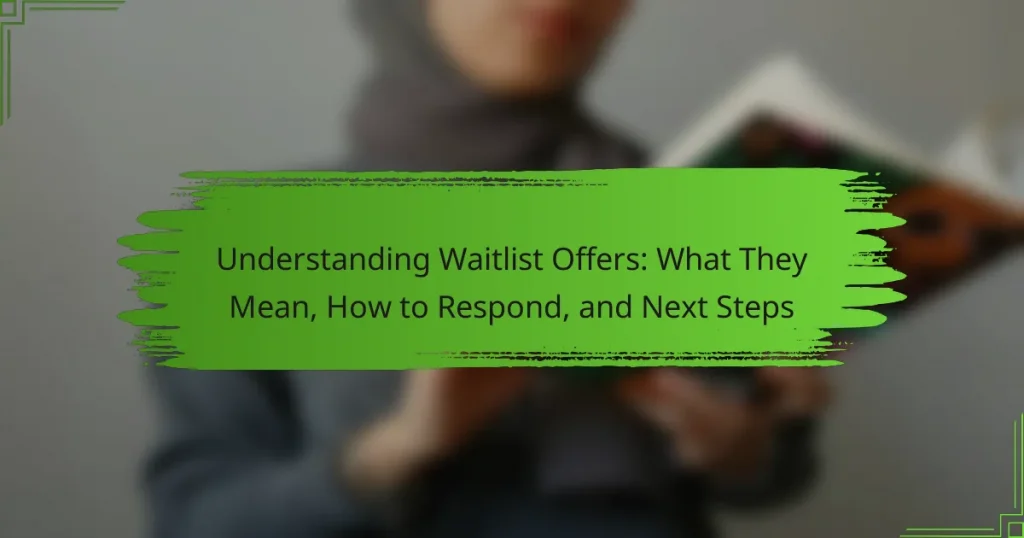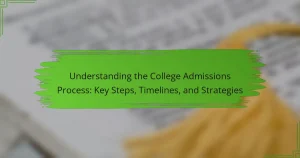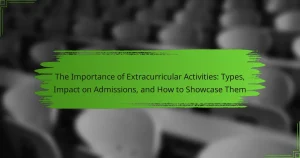
What are Waitlist Offers?
Waitlist offers are invitations extended by organizations to candidates who have not been initially accepted. These offers indicate that the candidate is on a waitlist for a position, such as in college admissions or job applications. Organizations use waitlist offers to fill vacancies if accepted candidates decline their offers. The waitlisted candidates may have the opportunity to enroll or take the position if it becomes available. This process allows organizations to maintain flexibility in their selection. Waitlist offers reflect the organization’s interest in the candidate while also managing capacity.
How do Waitlist Offers work?
Waitlist offers allow applicants to be considered for admission after the initial selection process. When an applicant is placed on a waitlist, it means they are not immediately accepted but may be offered a spot if space becomes available. Colleges and universities create waitlists to manage enrollment numbers effectively. If an accepted student declines their offer, the institution can then extend an offer to a waitlisted candidate. Applicants typically receive notification of their waitlist status via email or a portal update. They may be required to confirm their interest in remaining on the waitlist. The final decisions are usually communicated by a specific deadline, often in the spring. Waitlist offers provide an opportunity for applicants who might still be a good fit for the institution.
What are the key components of a Waitlist Offer?
A Waitlist Offer typically includes several key components. First, it communicates the applicant’s current status in the admissions process. Second, it outlines any specific conditions or requirements for remaining on the waitlist. Third, it provides an estimated timeline for when decisions will be made regarding waitlisted applicants. Fourth, it often includes instructions on how to respond to the offer. Lastly, it may detail the number of spots available and the likelihood of admission from the waitlist. Each of these components is crucial for applicants to understand their position and next steps.
How does the selection process for Waitlist Offers operate?
The selection process for waitlist offers operates by evaluating candidates based on their application strength and available spots. Admissions committees review waitlisted applicants after initial offers are accepted. They consider academic performance, extracurricular involvement, and personal statements. If spots open due to declined offers, the committee selects candidates from the waitlist. This selection often prioritizes those who closely match the institution’s criteria. The process typically occurs in late spring or early summer. Institutions may notify selected candidates via email or phone. The specific timeline can vary among schools.
Why are Waitlist Offers important?
Waitlist offers are important because they provide an opportunity for applicants who were not initially accepted. These offers indicate that the institution values the applicant’s potential. Being waitlisted means the applicant is still in consideration for admission. It allows the institution to fill spots if accepted students decline offers. According to the National Association for College Admission Counseling, about 20% of colleges use waitlists. This statistic shows the significance of waitlist offers in managing enrollment numbers. Additionally, waitlist offers can motivate applicants to improve their profiles for future opportunities.
What benefits do Waitlist Offers provide to applicants?
Waitlist offers provide applicants with the opportunity to remain in consideration for admission. This status indicates that the applicant is qualified but may not have been accepted due to limited spots. Applicants on a waitlist can still gain admission if openings arise. This allows them to keep their options open while waiting for a final decision. Additionally, being waitlisted can provide applicants with feedback for future applications. It can also indicate that the institution values their application. This feedback can help applicants improve their profiles for subsequent admissions cycles.
How can Waitlist Offers impact an applicant’s future opportunities?
Waitlist offers can significantly influence an applicant’s future opportunities. Being waitlisted indicates that the applicant is a strong candidate but not guaranteed admission. This status can motivate applicants to improve their qualifications or seek alternative options. Applicants may use the waitlist period to strengthen their profiles through additional coursework or experiences. Furthermore, a waitlist offer can open doors to networking opportunities with admissions staff. Many institutions review waitlisted candidates for future admissions cycles. Consequently, applicants can leverage their waitlist status for future applications. This can enhance their chances of acceptance at other institutions as well. Overall, waitlist offers serve as a pivotal moment for applicants to reassess and enhance their educational trajectory.

How should you respond to a Waitlist Offer?
Respond to a waitlist offer by expressing gratitude and confirming your interest. Acknowledge the offer promptly, ideally within a week. Indicate your continued enthusiasm for the program or opportunity. If applicable, provide any updates on your qualifications or achievements since your application. Follow any specific instructions given in the waitlist communication. This response demonstrates your commitment and keeps you on the institution’s radar. Research shows that timely and positive communication can improve chances of admission from the waitlist.
What steps should you take upon receiving a Waitlist Offer?
Upon receiving a waitlist offer, first, review the offer details carefully. Understand the specific terms and conditions associated with the waitlist. Next, respond promptly to the institution, indicating your continued interest. This shows your enthusiasm and commitment to attending. Additionally, consider reaching out to the admissions office for any updates or to express your interest further. You should also gather any additional materials that may enhance your application. This could include updated transcripts or recommendation letters. Finally, keep exploring other options while you await a final decision. This ensures you have alternatives if the waitlist does not result in an admission offer.
How can you effectively communicate your interest?
To effectively communicate your interest, express your enthusiasm clearly and concisely. Use direct language to convey your feelings about the opportunity. For example, state your excitement about the program or institution. Highlight specific aspects that attract you, such as faculty or resources. This shows you have researched the entity. Follow up with a personalized message, reinforcing your commitment. Timely communication demonstrates your eagerness. According to a survey by the National Association for College Admission Counseling, timely responses can positively influence decisions.
What information should you include in your response?
Include details about the waitlist offer, such as its significance and implications. Explain the reasons for being waitlisted, which often include limited spots or high competition. Describe how to respond effectively, including timelines for acceptance or rejection. Provide guidance on maintaining communication with the institution. Mention the importance of expressing continued interest and any additional materials that may strengthen the application. Highlight any deadlines associated with the waitlist.
What are common mistakes to avoid when responding to a Waitlist Offer?
Common mistakes to avoid when responding to a waitlist offer include not responding promptly. Timely communication shows interest and respect for the opportunity. Another mistake is failing to read the offer details carefully. Understanding terms and conditions is crucial for informed decisions. Additionally, applicants often overlook expressing gratitude. A polite acknowledgment can enhance rapport with the admissions team. Ignoring follow-up instructions is also common. Adhering to specific requests can improve chances of acceptance. Lastly, applicants sometimes provide vague responses. Clear and concise communication demonstrates professionalism and seriousness about the offer.
How can unclear communication affect your chances?
Unclear communication can significantly reduce your chances of success in waitlist situations. When messages are vague, it leads to misunderstandings about expectations. Applicants may not grasp what is required to improve their position. This uncertainty can result in missed opportunities to provide additional information. Furthermore, unclear communication can create frustration and anxiety. These emotions may hinder an applicant’s ability to respond effectively. Research indicates that clear communication increases engagement and action. In contrast, ambiguity often leads to inaction or incorrect responses. Therefore, clarity in communication is essential for maximizing chances in waitlist scenarios.
What should you avoid including in your response?
Avoid including personal opinions or emotional language in your response. Responses should be factual and objective. Focus on providing clear, concise information about waitlist offers. Do not include irrelevant details that do not pertain to the main topic. Avoid speculation about the admissions process or outcomes. Stay away from anecdotal evidence that lacks statistical backing. Refrain from discussing unrelated topics, such as personal experiences or external factors. Include only information that directly supports understanding of waitlist offers.

What are the next steps after accepting a Waitlist Offer?
After accepting a waitlist offer, the next step is to confirm your acceptance with the institution. This typically involves responding to the offer via email or an online portal. Next, you should monitor your email regularly for updates regarding your application status. Institutions may provide timelines for when they will notify waitlisted candidates of decisions. It is also advisable to maintain communication with the admissions office if you have questions. Additionally, consider securing alternative options in case you do not receive an offer of admission. This proactive approach ensures you have a plan regardless of the outcome.
How can you improve your chances of admission from the waitlist?
To improve your chances of admission from the waitlist, express your continued interest in the institution. Send a letter to the admissions office highlighting your enthusiasm for the program. Include any new achievements since your application, such as improved grades or awards. Request an update on your application status to show your proactive approach. Engage with current students or alumni to gain insights and strengthen your connection to the school. Attend any events or webinars hosted by the institution to demonstrate commitment. Research shows that applicants who actively communicate with admissions have a higher chance of being accepted from the waitlist.
What additional materials can you provide to strengthen your application?
You can provide additional materials such as updated transcripts, letters of recommendation, and personal statements. Updated transcripts demonstrate improved academic performance. Letters of recommendation from teachers or mentors can highlight your strengths. A personal statement can clarify your goals and reasons for interest in the institution. These materials can enhance your application by showcasing your commitment and growth.
How should you maintain communication with the admissions office?
Maintain communication with the admissions office through regular updates and inquiries. Use email as the primary method for clear documentation. Ensure your messages are concise and to the point. Include your full name and application details in each correspondence. Respond promptly to any requests or updates from the office. Schedule phone calls if necessary for urgent matters. Attend any scheduled information sessions or webinars. Follow up politely if you haven’t received a response within a reasonable timeframe. This approach fosters a professional relationship and keeps you informed about your application status.
What resources are available for applicants on the waitlist?
Applicants on the waitlist have access to several resources. These resources typically include information sessions, personalized communication from admissions staff, and online forums for peer support. Many institutions provide waitlist FAQs to clarify the process. Applicants may also receive updates on their status through email notifications. Some schools offer counseling services to help applicants navigate their options. Additionally, applicants can often find guidance on improving their application for future consideration. Each of these resources aims to assist applicants in understanding their position and making informed decisions.
Where can you find support and guidance during the waitlist process?
You can find support and guidance during the waitlist process through your school’s admissions office. They provide specific information about your status and next steps. Additionally, many institutions have dedicated resources such as counseling services. These services can help manage anxiety and provide clarity. Online forums and support groups can also be useful. They offer shared experiences and advice from others in similar situations. It’s important to reach out and utilize these resources for assistance.
What strategies can help you stay positive while waiting?
Engaging in positive self-talk can help maintain a positive mindset while waiting. This involves consciously replacing negative thoughts with affirmations. Practicing mindfulness techniques can also be beneficial. Mindfulness helps focus on the present moment rather than worrying about the future. Setting small, achievable goals during the waiting period can create a sense of progress. Staying connected with supportive friends or family can provide encouragement. Engaging in enjoyable activities can distract from feelings of impatience. Research shows that these strategies can improve overall well-being and reduce anxiety.
What are some best practices for navigating Waitlist Offers?
Respond promptly to a waitlist offer. This shows interest and may improve your chances of admission. Review the offer details carefully. Understand deadlines and requirements associated with the waitlist. Communicate with the admissions office if you have questions. Express your continued interest in the program. Submit any required materials or updates, such as grades or achievements. Stay proactive by remaining in touch with the institution. Research indicates that applicants who maintain contact have higher chances of acceptance.
Waitlist offers are invitations from organizations to candidates not initially accepted, indicating potential admission if spots become available. This article explains how waitlist offers work, including their key components, selection processes, and importance for applicants. It also outlines effective response strategies, common mistakes to avoid, and next steps after accepting a waitlist offer. Additionally, the article provides resources and best practices for applicants navigating the waitlist process to enhance their chances of admission.




